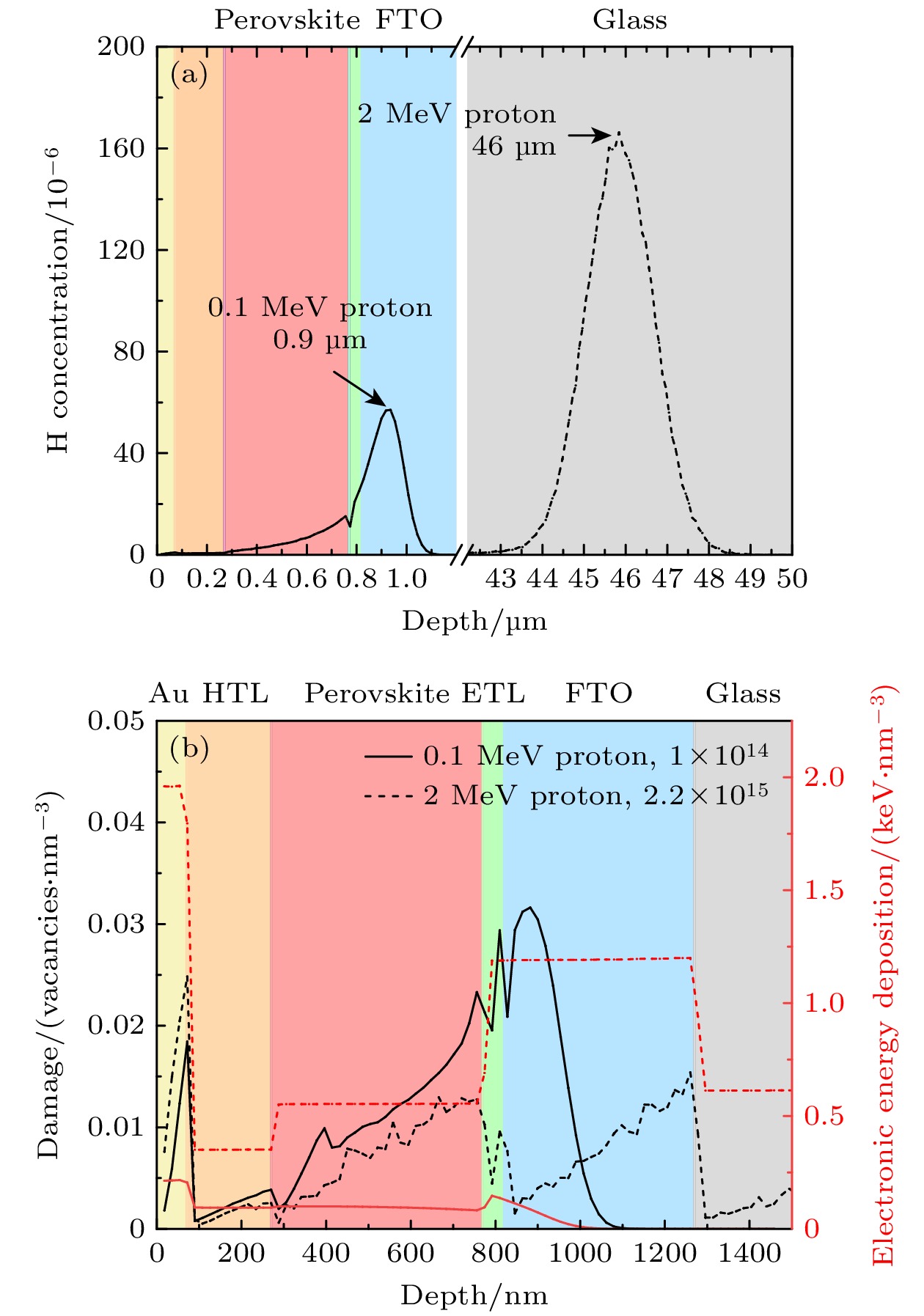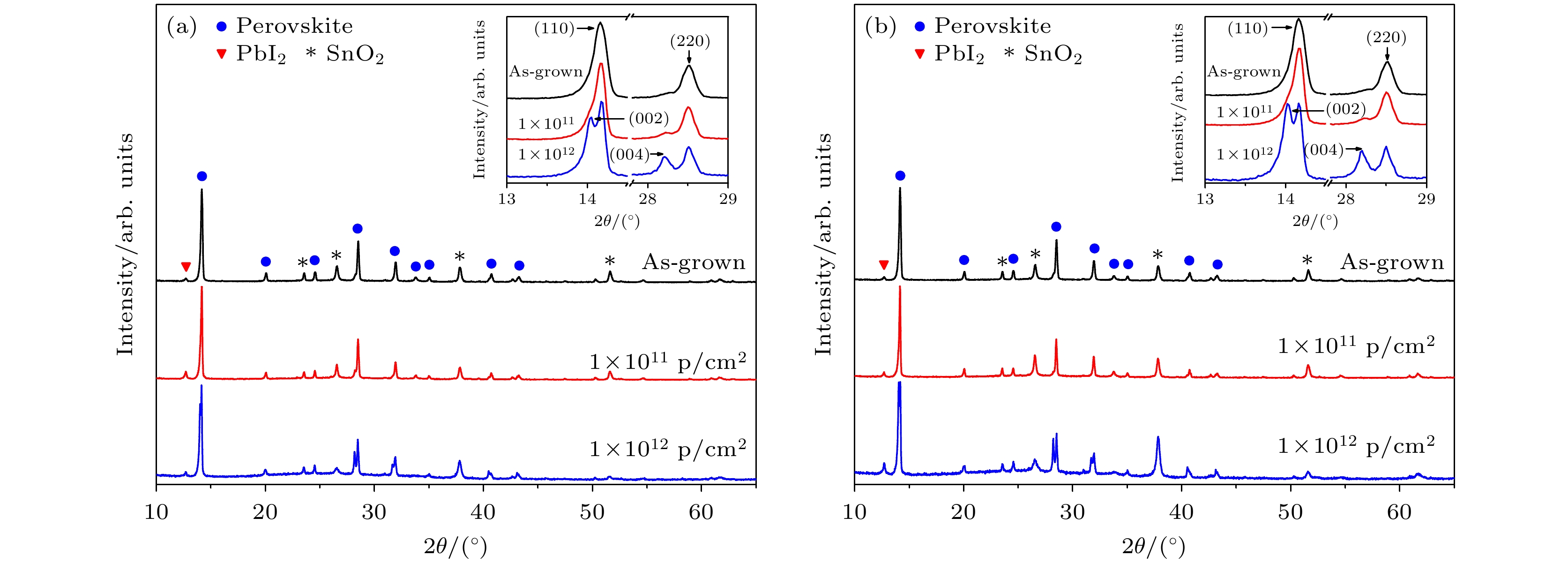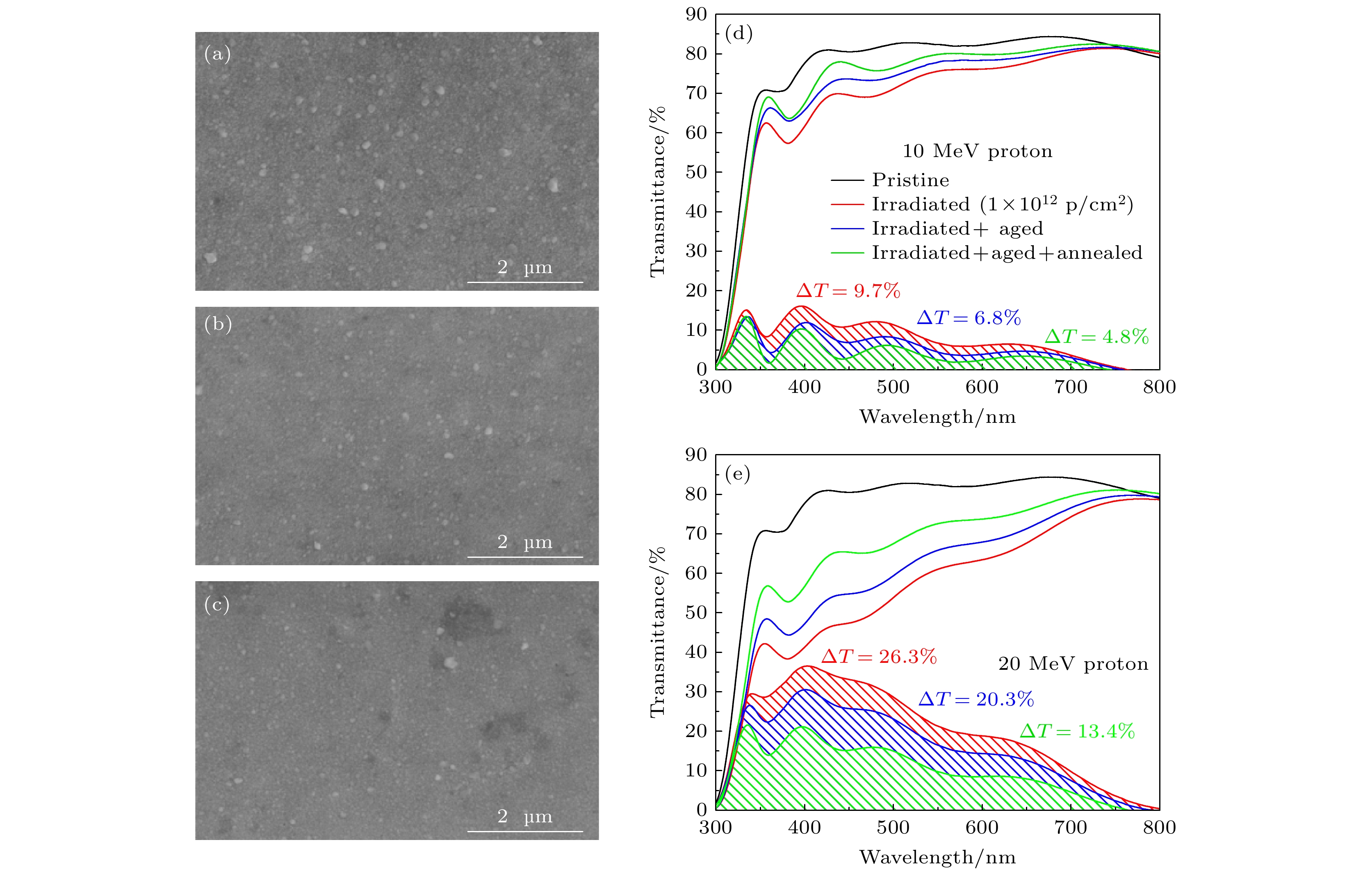-
针对钙钛矿太阳能电池 (PSCs)的空间应用, 研究了动能为0.1—20.0 MeV的质子在CH3NH3PbI3 (简称MAPbI3)薄膜及其太阳能电池中引起的损伤效应. 结果表明, PSCs具有良好质子辐照稳定性, 当0.1 MeV (2.0 MeV)质子的注量超过1×1013 p/cm2 (1×1014 p/cm2)时, 才会引起电池光电性能的降低. PSCs载流子传输层的辐照退化可能是造成电池性能降低的主要原因. MAPbI3中的有机成分MAI会在质子辐照作用下发生分解, 分解产生的气态产物(NH3和CH3I)将最终导致PSCs表面金电极的剥落. 对于具有更大离子射程的10 MeV和20 MeV质子, 入射质子会在PSCs的玻璃基底中产生色心缺陷, 造成玻璃对可见光透射率的降低. 色心缺陷可以在室温或100 ℃条件下发生热退火, 降低玻璃的透射损失.Perovskite solar cells (PSCs) have a great potential for space applications due to their high specific power, low cost and high defect tolerance. PSCs used in space will be subjected to high-energy particle irradiation, especially proton irradiation, resulting in the decline of photovoltaic (PV) performance. However, the research on proton irradiation effects in PSCs is still in its infancy stage. In this work, the CH3NH3PbI3 (MAPbI3) thin films and their PSCs are irradiated by protons with energy of 0.1, 2, 10, 20 MeV, etc. Irradiation-induced changes in PV parameters of the PSCs are studied as a function of proton fluence. The structural and surface morphological changes of the irradiated MAPbI3 films and Au electrode layers of PSCs are characterized by X-ray diffraction and scanning electron microscopy. In addition, UV spectrophotometer is also employed to analyze the transmission loss in glass substrate induced by proton irradiation. It is found that PSCs exhibit superior resistance against proton irradiation. The PV properties of the PSCs don’t degrade after 0.1 MeV (2 MeV) proton irradiation up to a fluence of 1×1013 p/cm2 (1×1014 p/cm2). The irradiation-induced damage in the charge transport layers may be the main cause for the performance degradation of PSCs. The gaseous products (NH3 and CH3I) of perovskite decomposition eventually lead to exfoliation of the top Au electrode from the PSCs. Regarding 10 and 20 MeV proton irradiation with larger projected ion ranges, the irradiations create color center defects in glass substrate of PSCs, which results in a decrease in light transmission of visible spectrum. However, the color center defects, specifically non-bridging oxygen hole centers, will be partly annealed at room temperature or 100 ℃, reducing the transmission loss in glass. The reported results may help predict the performance degradation of PSCs in space irradiation environment.
-
Keywords:
- perovskite solar cells /
- proton irradiation /
- irradiation effects
[1] Kojima A, Techima K, Shirai Y, Miyasaka T 2009 J. Am. Chem. Soc. 131 6050
 Google Scholar
Google Scholar
[2] Jeon N J, Noh J H, Yang W S, Kim Y C, Ryu S, Seo J, Seok S I 2015 Nature 517 476
 Google Scholar
Google Scholar
[3] Saliba M, Matsui T, Seo J Y, Domanski K, Correa-Baena J P, Nazeeruddin M K, Zakeeruddin S M, Tress W, Abate A, Hagfeldt Anders, Grätzel M 2016 Energy Environ. 9 1989
 Google Scholar
Google Scholar
[4] Min H, Lee D Y, Kim J, Kim G, Lee K S, Kim J, Paik M J, Kim Y K, Kim K S, Kim M G, Shin T J, Seok S I 2021 Nature 598 444
 Google Scholar
Google Scholar
[5] Kang S, Jeong J, Cho S, Yoon Y J, Park S, Lim S, Kim J Y, Ko H 2019 J. Mater. Chem. A 7 1107
 Google Scholar
Google Scholar
[6] AZUR SPACE. http://www.azurspace.com/index.php/en/ [2022-09-14]
[7] Kheraj V, Simond B J, Toshniwal A, Misra S, Peroncik P, Zhang C, Vardeny Z V, Scarpulla M A 2018 J. Lumin. 194 353
 Google Scholar
Google Scholar
[8] Tu Y, Wu J, Xu G, Yang X, Cai R, Gong Q, Zhu R, Huang W 2021 Adv. Mater. 33 2006545
 Google Scholar
Google Scholar
[9] Yang J, Bao Q, Shen L, Ding L 2020 Nano Energy 76 105019
 Google Scholar
Google Scholar
[10] Miyazawa Y, Ikegami M, Chen H W, Ohshima T, Imaizumi M, Hirose K, Miyasaka T 2018 iScience 2 148
 Google Scholar
Google Scholar
[11] Xiong G, Qin Z, Li B, Wang L, Zhang X, Zheng Z, Zhu H, Zhao S, Gao J, Li B, Yang J, Li X, Luo J, Han Z, Liu X, Zhao F 2021 J. Mater. Chem. C 9 2095
 Google Scholar
Google Scholar
[12] Durant B K, Afshari H, Singh S, Rout B, Eperon G E, Sellers I R 2021 ACS Energy Lett. 6 2362
 Google Scholar
Google Scholar
[13] Barbé J, Hughes D, Wei Z, Pockett A, Lee H K H, Heasman K C, Carnie M J, Watson T M, Tsoi W C 2019 Sol. Rrl. 3 1900219
 Google Scholar
Google Scholar
[14] Brus V V, Lang F, Bundesmann J, Seidel S, Denker A, Rech B, Landi G, Neitzert H C, Rappich J, Nickel N H 2017 Adv. Electron. Mater. 3 1600438
 Google Scholar
Google Scholar
[15] Boldyreva A G, Frolova L A, Zhidkov I S, Gutsev L G, Kurmaev E Z, Ramachandran B R, Petrov V G, Stevenson K J, Aldoshin S M, Troshin P A 2020 J. Phys. Chem. Lett. 11 2630
 Google Scholar
Google Scholar
[16] Boldyreva A G, Akbulatov A F, Tsarev S A, Luchkin S Y, Zhidkov I S, Kurmaev E Z, Stevenson K J, Petrov V G, Troshin P A 2019 J. Phys. Chem. Lett. 10 813
 Google Scholar
Google Scholar
[17] Tu Y, Xu G, Yang X, Zhang Y, Li Z, Su R, Luo D, Yang W, Miao Y, Cai R, Jiang L, Du X, Yang Y, Liu Q, Yang G, Zhao S, Huang W, Gong Q, Zhu R 2019 Sci. China-Phys. Mech. Astron. 62 7
 Google Scholar
Google Scholar
[18] Kirmani A R, Durant B K, Grandidier J, Haegel N M, Kelzenberg M D, Lao Y M, McGehee M D, McMillon-Brown L, Ostrowski D P, Peshek T J, Rout B, Sellers I R, Steger M, Walker D, Wilt D M, VanSant K T, Luther J M 2022 Joule 6 1015
 Google Scholar
Google Scholar
[19] Ziegler J F, Ziegler M D, Biersack J P 2010 Nucl. Instrum. Methods. Phys. Res. B 268 1818
 Google Scholar
Google Scholar
[20] Xue B, Zhang L, Li Z, Jiang W, Liang Y, Liu N, Pan C, Chen L, Wang T 2022 Nucl. Instrum. Methods. Phys. Res. B 526 29
 Google Scholar
Google Scholar
[21] Serge T G, Bernard Z, Bruno K, Boubacar S, Mahamadi S, Martial Z, Issa Z 2019 Int. J. Photoenergy 2019 8306492
 Google Scholar
Google Scholar
[22] Ohshima T, Sato S, Imaizumi M, Nakamura T, Sugaya T, Matsubara K, Niki S 2013 Sol. Energy Mater Sol. Cells 108 263
 Google Scholar
Google Scholar
[23] Jacobsson T J, Correa-Baena J P, Anaraki E H, Philippe B, Stranks S D, Bouduban M E F, Tress W, Schenk K, Teuscher J, Moser J E, Rensmo H, Hagfeldt A 2016 J. Am. Chem. Soc. 138 10331
 Google Scholar
Google Scholar
[24] Yang J, Hong Q, Yuan Z, Xu R, Guo X, Xiong S, Liu X, Braun S, Li Y, Tang J, Duan C, Fahlman M, Bao Q 2018 Adv. Optical Mater. 12 1800262
 Google Scholar
Google Scholar
[25] Chaudhary B, Kulkarni A, Jena A K, Ikegami M, Miyasaka T 2020 Energy Technol. 8 1900990
 Google Scholar
Google Scholar
[26] Jena A K, Ikegami M, Miyasaka T 2017 ACS Energy Lett. 2 1760
 Google Scholar
Google Scholar
[27] Kim S, Bae S, Lee S, Cho K, Lee K D, Kim H, Park S, Kwon G, Ahn S W, Lee H M, Kang Y, Lee H S, Kim D 2017 Sci. Rep. 7 1200
 Google Scholar
Google Scholar
[28] Mejri A, Farah K, Eleuch H, Ouada H B 2008 Radiat. Meas. 43 1372
 Google Scholar
Google Scholar
[29] Sheng J W, Kadono K, Yazawa T 2002 Appl. Radiat. Isot. 57 813
 Google Scholar
Google Scholar
[30] Acha C, Sanca G A, Barella M, Alurralde M, Marlasca F G, Huhtinen H, Paturi P, Golmar F, Levy P 2021 Radiat. Phys. Chem. 183 109404
 Google Scholar
Google Scholar
-
图 2 SRIM预测的注量为1×1014 p/cm2的0.1 MeV质子(黑色与红色实线)和注量为2.2×1015 p/cm2的2 MeV质子(黑色与红色虚线)在PSCs样品中产生的注入H原子浓度(a)和离位损伤与电子能量沉积分布(b)
Fig. 2. SRIM-predicted depth profiles of implanted H atomic concentrations (a) and atomic displacement damage and electronic energy deposition (b) in PSCs irradiated with 0.1 MeV protons to 1×1014 p/cm2 (black and red solid line) and 2 MeV protons to 2.2×1015 p/cm2 (black and red dotted line).
图 6 质子辐照前后PSCs Au电极表面的SEM图像 (a) 辐照前; (b) 0.1 MeV质子辐照后; (c), (d) 2 MeV质子辐照后. (e) SnO2/FTO/玻璃基底的透射谱
Fig. 6. SEM images of the Au electrode surface of PSCs before and after proton irradiations: (a) Before irradiations; (b) after irradiations with 0.1 MeV proton; (c), (d) after irradiations with 2 MeV proton. (e) Transmittance spectra of SnO2/FTO/glass substrates.
图 7 SRIM预测的2, 10和20 MeV质子在PSCs玻璃基底中产生的电子能量沉积分布(10和20 MeV质子的注量为1×1012 p/cm2, 2 MeV质子的注量为2.2×1015 p/cm2)
Fig. 7. SRIM-predicted depth profiles of electronic energy deposition in the glass substrates of PSCs irradiated with 2, 10 and 20 MeV protons (10 and 20 MeV proton fluences are 1×1012 p/cm2, and 2 MeV proton fluence is 2.2×1015 p/cm2)
图 10 质子(注量均为1×1012 p/cm2)辐照前后PSCs Au电极表面的SEM图像 (a) 辐照前; (b), (c) 分别为10和20 MeV质子辐照后. (d), (e) SnO2/FTO/玻璃基底透射谱
Fig. 10. SEM images of Au electrode surface of PSCs before and after irradiations with 10 and 20 MeV proton (Proton fluences are 1×1012 p/cm2): (a) Before irradiations; (b), (c) after irradiations with 10 and 20 MeV proton, respectively; (d), (e) Transmittance spectra of SnO2/FTO/glass substrates.
表 1 用于质子辐照实验的原生PSCs样品的PV参数
Table 1. PV parameters of as-prepared PSCs sample used for proton irradiation experiments.
质子能量/MeV VOC/V JSC/(mA·cm–2) FF PCE/% 0.1 1.02 ± 0.04 18.40 ± 0.72 0.68 ± 0.03 12.75 ± 0.63 2.0 1.04 ± 0.04 18.88 ± 0.58 0.71 ± 0.03 14.08 ± 1.18 10.0 1.08 ± 0.02 18.10 ± 0.41 0.75 ± 0.02 14.66 ± 0.82 20.0 1.08 ± 0.02 18.37 ± 0.39 0.74 ± 0.02 14.58 ± 0.68 表 2 不同能量质子辐照实验的注量率和注量范围
Table 2. Flux and fluence for proton irradiations with different proton energies.
质子能量
/MeV注量率
/(108 p·cm–2·s–1)注量范围
/(p·cm–2)0.1 5000 1×1012—1×1014 2.0 104 1×1012—2.2×1015 10.0 和 20.0 1 3×109—1×1012 -
[1] Kojima A, Techima K, Shirai Y, Miyasaka T 2009 J. Am. Chem. Soc. 131 6050
 Google Scholar
Google Scholar
[2] Jeon N J, Noh J H, Yang W S, Kim Y C, Ryu S, Seo J, Seok S I 2015 Nature 517 476
 Google Scholar
Google Scholar
[3] Saliba M, Matsui T, Seo J Y, Domanski K, Correa-Baena J P, Nazeeruddin M K, Zakeeruddin S M, Tress W, Abate A, Hagfeldt Anders, Grätzel M 2016 Energy Environ. 9 1989
 Google Scholar
Google Scholar
[4] Min H, Lee D Y, Kim J, Kim G, Lee K S, Kim J, Paik M J, Kim Y K, Kim K S, Kim M G, Shin T J, Seok S I 2021 Nature 598 444
 Google Scholar
Google Scholar
[5] Kang S, Jeong J, Cho S, Yoon Y J, Park S, Lim S, Kim J Y, Ko H 2019 J. Mater. Chem. A 7 1107
 Google Scholar
Google Scholar
[6] AZUR SPACE. http://www.azurspace.com/index.php/en/ [2022-09-14]
[7] Kheraj V, Simond B J, Toshniwal A, Misra S, Peroncik P, Zhang C, Vardeny Z V, Scarpulla M A 2018 J. Lumin. 194 353
 Google Scholar
Google Scholar
[8] Tu Y, Wu J, Xu G, Yang X, Cai R, Gong Q, Zhu R, Huang W 2021 Adv. Mater. 33 2006545
 Google Scholar
Google Scholar
[9] Yang J, Bao Q, Shen L, Ding L 2020 Nano Energy 76 105019
 Google Scholar
Google Scholar
[10] Miyazawa Y, Ikegami M, Chen H W, Ohshima T, Imaizumi M, Hirose K, Miyasaka T 2018 iScience 2 148
 Google Scholar
Google Scholar
[11] Xiong G, Qin Z, Li B, Wang L, Zhang X, Zheng Z, Zhu H, Zhao S, Gao J, Li B, Yang J, Li X, Luo J, Han Z, Liu X, Zhao F 2021 J. Mater. Chem. C 9 2095
 Google Scholar
Google Scholar
[12] Durant B K, Afshari H, Singh S, Rout B, Eperon G E, Sellers I R 2021 ACS Energy Lett. 6 2362
 Google Scholar
Google Scholar
[13] Barbé J, Hughes D, Wei Z, Pockett A, Lee H K H, Heasman K C, Carnie M J, Watson T M, Tsoi W C 2019 Sol. Rrl. 3 1900219
 Google Scholar
Google Scholar
[14] Brus V V, Lang F, Bundesmann J, Seidel S, Denker A, Rech B, Landi G, Neitzert H C, Rappich J, Nickel N H 2017 Adv. Electron. Mater. 3 1600438
 Google Scholar
Google Scholar
[15] Boldyreva A G, Frolova L A, Zhidkov I S, Gutsev L G, Kurmaev E Z, Ramachandran B R, Petrov V G, Stevenson K J, Aldoshin S M, Troshin P A 2020 J. Phys. Chem. Lett. 11 2630
 Google Scholar
Google Scholar
[16] Boldyreva A G, Akbulatov A F, Tsarev S A, Luchkin S Y, Zhidkov I S, Kurmaev E Z, Stevenson K J, Petrov V G, Troshin P A 2019 J. Phys. Chem. Lett. 10 813
 Google Scholar
Google Scholar
[17] Tu Y, Xu G, Yang X, Zhang Y, Li Z, Su R, Luo D, Yang W, Miao Y, Cai R, Jiang L, Du X, Yang Y, Liu Q, Yang G, Zhao S, Huang W, Gong Q, Zhu R 2019 Sci. China-Phys. Mech. Astron. 62 7
 Google Scholar
Google Scholar
[18] Kirmani A R, Durant B K, Grandidier J, Haegel N M, Kelzenberg M D, Lao Y M, McGehee M D, McMillon-Brown L, Ostrowski D P, Peshek T J, Rout B, Sellers I R, Steger M, Walker D, Wilt D M, VanSant K T, Luther J M 2022 Joule 6 1015
 Google Scholar
Google Scholar
[19] Ziegler J F, Ziegler M D, Biersack J P 2010 Nucl. Instrum. Methods. Phys. Res. B 268 1818
 Google Scholar
Google Scholar
[20] Xue B, Zhang L, Li Z, Jiang W, Liang Y, Liu N, Pan C, Chen L, Wang T 2022 Nucl. Instrum. Methods. Phys. Res. B 526 29
 Google Scholar
Google Scholar
[21] Serge T G, Bernard Z, Bruno K, Boubacar S, Mahamadi S, Martial Z, Issa Z 2019 Int. J. Photoenergy 2019 8306492
 Google Scholar
Google Scholar
[22] Ohshima T, Sato S, Imaizumi M, Nakamura T, Sugaya T, Matsubara K, Niki S 2013 Sol. Energy Mater Sol. Cells 108 263
 Google Scholar
Google Scholar
[23] Jacobsson T J, Correa-Baena J P, Anaraki E H, Philippe B, Stranks S D, Bouduban M E F, Tress W, Schenk K, Teuscher J, Moser J E, Rensmo H, Hagfeldt A 2016 J. Am. Chem. Soc. 138 10331
 Google Scholar
Google Scholar
[24] Yang J, Hong Q, Yuan Z, Xu R, Guo X, Xiong S, Liu X, Braun S, Li Y, Tang J, Duan C, Fahlman M, Bao Q 2018 Adv. Optical Mater. 12 1800262
 Google Scholar
Google Scholar
[25] Chaudhary B, Kulkarni A, Jena A K, Ikegami M, Miyasaka T 2020 Energy Technol. 8 1900990
 Google Scholar
Google Scholar
[26] Jena A K, Ikegami M, Miyasaka T 2017 ACS Energy Lett. 2 1760
 Google Scholar
Google Scholar
[27] Kim S, Bae S, Lee S, Cho K, Lee K D, Kim H, Park S, Kwon G, Ahn S W, Lee H M, Kang Y, Lee H S, Kim D 2017 Sci. Rep. 7 1200
 Google Scholar
Google Scholar
[28] Mejri A, Farah K, Eleuch H, Ouada H B 2008 Radiat. Meas. 43 1372
 Google Scholar
Google Scholar
[29] Sheng J W, Kadono K, Yazawa T 2002 Appl. Radiat. Isot. 57 813
 Google Scholar
Google Scholar
[30] Acha C, Sanca G A, Barella M, Alurralde M, Marlasca F G, Huhtinen H, Paturi P, Golmar F, Levy P 2021 Radiat. Phys. Chem. 183 109404
 Google Scholar
Google Scholar
计量
- 文章访问数: 4775
- PDF下载量: 101
- 被引次数: 0














 下载:
下载:









